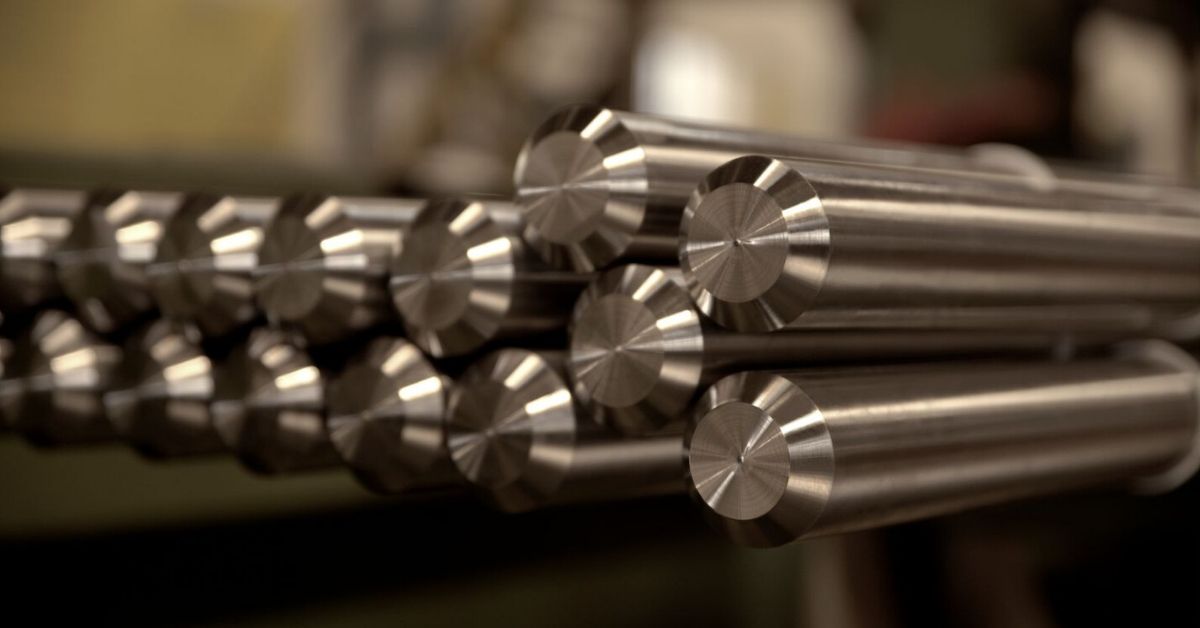Stainless Steel bars are a common raw material used in construction and finishing work. They are widely used across all manner of industries and applications. Some common applications are architectural design, marine equipment, oil/gas pipelines, automotive components, etc.
Stainless steel rods and bars have a number of valuable characteristics, the most prominent being corrosion resistance. These rods are available in different shapes and formats in the market, which includes round bars, flat bars, square bars, and hexagonal bars.
Stainless Steel Bars are either hot rolled or cold drawn. Hot-rolled bars have a comparatively rough surface than the drawn bars. These bars are used only for their strength and corrosion resistance property. On the other hand, cold drawn bars are used in aesthetic applications and outdoor fixtures. Cold drawn bars are preferred due to their smooth surface. One such cold drawn bar is a stainless steel piston bar, which is a variant of stainless steel round bars. The general range of stainless steel piston high-quality bars is from 6mm to 100mm radius.
Key Characteristics of Stainless Steel Piston Bars
- Since stainless steel is a relatively strong material, stainless steel piston rods are the best choice for structural applications.
- Being non-porous is a key factor that makes stainless steel cold drawn bars corrosion-resistant.
- Cold rolled piston bars made of stainless steel have a smooth surface, which makes them hygienic, low in maintenance, and non-reactive to many substances. That’s why they are commonly used in kitchen environments.
At Aamor Inox, we offer premium stainless steel piston rod quality bars that are processed in our ultra-modern facilities to make high-grade steel of international standard. To avoid any internal defects in the finished product, we use Ultrasonic Inspection and Eddy Current Testing. The finishing is done by specially designed machines to ensure that the size tolerance and surface roundness are achieved as desired.
Our cold drawn bars go through various types of heat treatment and are 100% tested through digital ultrasonic flaw detectors to ensure the premium quality. Our cold-rolled stainless steel piston rod quality bars can be used in pump shafts, hydraulic piston shafts, cylinder shafts, boat shafts, bearing sized shafts, and chrome plating quality bars.
| Size Range | 6 mm – 100 mm (1/4 – 4 inch) |
| Size Tolerances | j6, e6, h6, f6, f7, h7, f8, h8, h9, ½ of A484 etc |
| Length | 1 meter upto 8 meters (upto 26 feet) |
| Ovality | Half of diameter tolerance |
| Heat Treatment | Annealed, Solution Annealed, Quenched & Tempered (QT), Hardened & Tempered (HT), Quenched & Double Tempered (QDT) |
| Straightness | 0.25mm per meter max (0.0015” per feet) |
| Surface Finish | Ra – 0.2 um / 12 RMS max |
| Chamfering | Available in 30, 45 & 60 degree thru fully automatic both-end chamfering machine |
| Crack Test | Eddy Current Testing thru Circograph (from Dr. Foerster, Germany) and Magnetic Particle Inspection (MPI) |
| Ultrasonic Test | 100% tested thru Digital Ultrasonic Flaw Detector, as per ASTM A-388, EN 10308 (class 1 to 4), API 6A/ISO 10423:2003-PSL 3, SEP 1920:1984 (class A, B, C), MIL STD 2154 |
| Length Tolerance | Available in special cut to length bars in tolerance – 0/+10mm (-0 +0.5 inch) |
| Grades | 303, 304L, 310S, 316L, 316Ti, 321, 403, 410, 416, 420, 420B, 420C, 430F, 431, 17-4ph, Duplex F51 (2205) 1.4305, 1.4307, 1.485, 1.404, 1.4571, 1.4541, 1.4006, 1.4005, 1.4021, 14028, 1.4034, 1.4104, 1.4057, 1.4542, 1.4462 |
| Packaging | Packing is done using a variety or protective materials & distance rings, and then placed in the strong plywood boxes to ensure safety of material during transportation. |
Based out of Delhi/NCR, India, Aamor Inox is a leading manufacturer and supplier of Stainless Steel Piston Rod Bars. These can be customized into different sizes and grades with excellent accuracy according to the requirements of the client at reasonable prices. We export our products to over 60 countries worldwide. Please share your inquiries with us on anand@aamorinox.com and we’ll get back to you as soon as possible. If you’re interested in the purchase of any stainless steel metal product, here is our contact number 0120-4564585. You can also request a quotation online by filling the form below.
Stainless steel round bars are corrosion-resistant and rust-free, which makes them suitable for use in huge factories dealing with chemicals. Besides being resistant to heat and fire, stainless steel does not corrode, as it does not react to chemicals.
Made of a durable alloy with high life expectancy, stainless steel round bars are also stain-free, which lends them an attractive appearance. Additionally, they are heavy and can withstand extreme conditions. These round bars have wide industrial applications, including those that involve chemical processing and/or high-saline environments.
Stainless steel round bars are used in a variety of machinery, mechanisms, valves, fittings, vessels, flanges, threading bars, subways, chemical and fuel tankers, signboards, escalators, elevators, lifts, and petrochemicals.
Stainless steel round bars are also highly useful in the manufacturing of medical surgical instruments, thanks to their non-reactive properties. Durable, easy to clean, perfectly welded and finished, stainless steel bright round bars have some typical applications which include the following:
- Food Preparation Equipment.
- Laboratory Benches and Equipment.
- Boat Fittings.
- Chemical containers, including for transport.
- Heat exchangers.
- Threaded fasteners.
Additionally, stainless steel round bars are used in hydraulics where they get a more cogent internal structure. Their ability to withstand warping and wearing is also considerably high, when used for this purpose.
These mirror-finished round bars are completely machine-made, without involving any human intervention. Therefore, they are not only visually pleasing but also offer absolute precision, ductility, and durability.
Polished Stainless Steel Round Bar Grades
| Grade | Thickness/Diameter |
| SS 304 Round Bar | Upto 5 inches |
| SS 304L Round Bar | 3-4 inch,2-3 inch |
| SS 316 Round Bar | 36 meter,6 meter |
| SS 316L Round Bar | 0-1 inch,3-4 inch |
| SS 303 Round Bar | 3-4 inch |
Sizes of Stainless Steel Round Bars
| Type | SIZES (mm) |
| Cold Drawn and Polish | 3.00 – 75.00 |
| Cold Drawn and Ground | 10.00 – 75.00 |
| Peeled and Polished | 40.00 – 150.00 |
| Peeled and Ground | 20.00 – 50.00 |
Based out of Delhi-NCR, India, Aamor Inox is a leading manufacturer and supplier of Stainless Steel Round Bars. We export our products to over 60 countries worldwide. Please share your enquiries with us at anand@aamorinox.com and we’ll get back to you soonest.
A wire rod is a hot rolled wire, which can have a diameter of anywhere from 5.5 to 42mm. A standard quality rod can be made of various materials such as carbon steel, stainless steel, aluminium, and ordinary quality copper. However, stainless steel wire rods offer unparalleled quality with high corrosion resistance and high weldability. Depending upon the technical parameters of the material type, the cross-section of wire rods can be hexagonal, round or square. But the majority production of wire rods is in round cross-section in nominal diameters of 5mm to 19mm.
Manufacturing of Wire Rods
Wire rods are manufactured by hot rolling billets on continuous rolling mills. It is extracted from hot metal through shafts. The shafts shape and compress the metal from various sides, transforming a piece of metal into a thin, long cable.
The rod needs to be cooled after rolling. This wire is wound on a special winder at the end of the rolling mill for the further cooling process. There are two ways this process can go: by air or rapid cooling. Unlike rapid air cooling, which involves special fans, air cooling happens naturally. The rod is ready for storage after cooling.
Usage of Wire Rods
There are a variety of applications for stainless steel wire rods, such as aviation, industrial, engineering, and for reinforcing concrete structures. These HRAP wire rods can be used in cold drawing, metal wiring, binding, fastener applications and to make stainless steel wire mesh.
Stainless steel wire rods are mainly used to produce stainless steel wire. In order to manufacture downstream products such as industrial fasteners, springs, medical and dental devices, automobile components, and welding electrodes, stainless steel wire is used.
In India, Aamor Inox is one of the leading manufacturers and suppliers of premium quality Stainless Steel Wire Rods. We provide exceptional quality stainless steel rods in various AISI and DIN International standard grades and sizes. Our division is well equipped with the necessary machinery and tools where the process of solution annealing is done in a controlled environment. We have expertise in in-house melting operations to produce the best quality annealed stainless steel wire rods.
Based out of New Delhi, India, Aamor Inox exports various stainless steel products to over 60 countries worldwide. Please share your enquiries with us on anand@aamorinox.com, and we’ll get back to you as soon as possible.
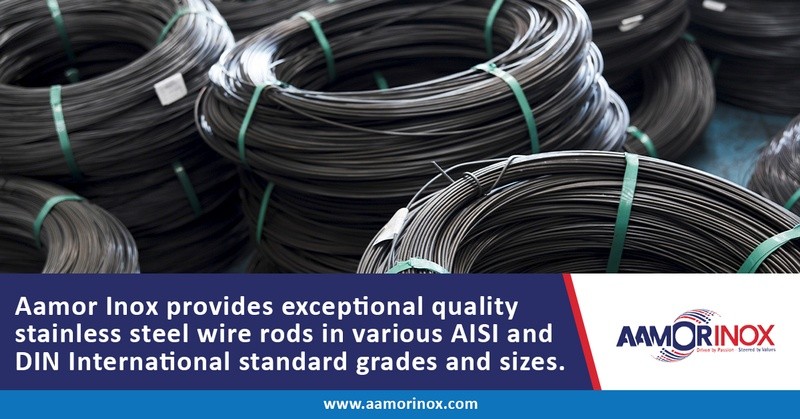
Stainless steel angles are the simplest but one of the most easily identifiable profiles of stainless steel. It comes with several benefits for a variety of uses. Stainless steel angles are one of the most common structural shapes in building and construction. In its simplest form, you can expect a stainless steel angle with the shape of an L and flat surfaces that extend both horizontally and vertically. These surfaces meet at a 90 degrees angle. Available in both equal and unequal leg dimensions, these stainless steel angles are manipulated by engineers. They basically play around with the strength distribution of each leg, depending on the design required.
Since stainless steel angles are light and compact, they are very easy to work with, irrespective of the application. They are also very versatile, as they come in different sizes and alloys. Using stainless steel angles in your design will minimize replacement costs and enhance the life-cycle of the structure concerned. The most common production methods of stainless steel angles include –
- Laser fusion
- Hot rolling
- Cold drawn
Stainless steel angles uses
Stainless steel angle finds wide usage in construction, bridges, equipment, framing, shelving, furniture, and so on. They are highly advantageous in corrosion-prone environments such as chemical plants, food and beverage processing plants, marine applications, etc. Since they are made of stainless steel, they are extremely durable and will not get rusted even after years of use. While wooden construction comes with a limited lifespan, stainless steel angles need no replacement for a long period of time. Equipped with weather protecting feature, stainless steel angles when used to make roofs, can shed winter snow easily and also keep the home cool during the hot and sultry summers. These stainless steel angles are also highly resistant to fire, insects, rot, and mildew.
Whether you own a construction firm or are simply a homeowner, you can reap the benefits of a well-constructed property by using stainless steel angles. With distinct shapes, these are not only reliable but promise high value-for-money. Wood or lumber often fails to provide that specific structure with sufficient support that you need, which on the other hand, is guaranteed by stainless steel angles. They come in various sizes and lengths to fit your needs.
Aamor Inox is one of the leading manufacturers and suppliers of stainless steel angles with the length being around 6 metres (20 feet). We offer size ranges of 20x20x3mm up to 80x080x8mm. we will cater to your customized requirements and ensure absolute satisfaction with our product quality and specifications.
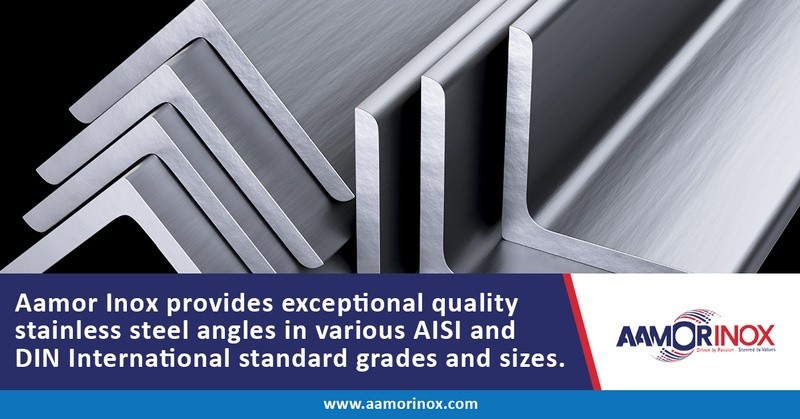
Stainless steel is an alloy made up of different metals. When these metals are mixed in different quantities, they produce several variations of the alloy. Each variation has its own features and uses. There are over 150 varieties of stainless steel, and each of them has different properties, which are further split into grades.
For the food service industry, there are two types of stainless steel: SAE Grades and Flatware Grades. These two grades are commonly known as food-grade stainless steel.
Stainless steel is a fantastic metal, and that’s why it’s so widely used in the kitchen. It doesn’t break, bend or crack and stays shiny for years. Ever wondered why it’s so commonly used in the food service industry? Why not aluminium? Why not iron? Let’s find out.
Benefits of using stainless steel utensils:
- Corrosion-resistance: Stainless steel is a non-reactive metal alloy with 10-11% chromium. On being exposed to air, chromium forms a layer of chromium oxide over the surface. This layer prevents the steel from rusting by shielding it from moisture.
- Non-reactive surface: Unlike aluminium and iron, stainless steel is a non-reactive metal. It means you can cook acidic foods in stainless steel utensils without affecting the flavour of the food and without damaging the surface of the metal.
- Strength: Food grade stainless steel is strong and can be used in heavy-duty equipment or in shelving for storage areas.
- Ease of Cleaning: Cleanliness is an essential requirement of the food industry. Usually, wooden or plastic utensils have several openings where bacteria can grow if they are not cleaned properly. Compared to that, stainless steel has a smooth surface, and it doesn’t have any room for bacteria growth in the utensil.
Amongst lots of metals available in the market, stainless steel is considered as one of the best materials for kitchen utensils. It is incredibly useful due to its strength, durability, and corrosion resistance. It’s not just the food industry; stainless steel is useful in countless applications in different other industries as well.
In India, Aamor Inox is one of the leading manufacturers and suppliers of premium quality Stainless Steel products. We cater to diverse clientele around the world by manufacturing high-quality stainless steel products.
We serve different industries like dairy, instruments, pulp and paper, medical, etc. Based out of New Delhi, India, we export various stainless steel products to over 60 countries worldwide. Please share your enquiries with us on anand@aamorinox.com, and we’ll get back to you as soon as possible.
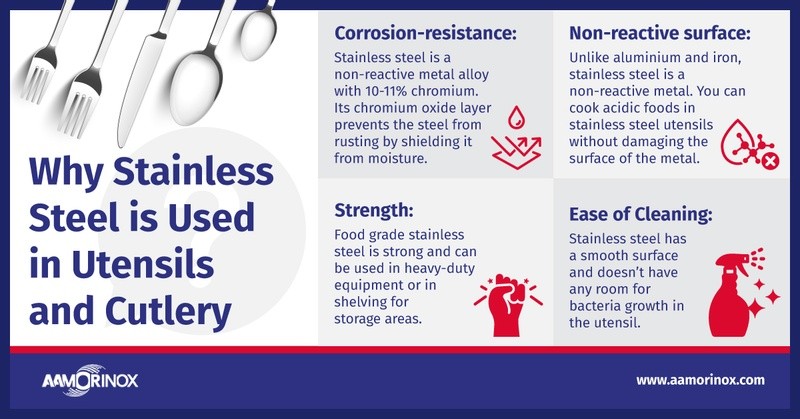
Stainless steel finds wide application in almost every aspect of architecture, building, and construction. Way back in the 1920s, stainless steel made its way into architecture and construction, and over the years, its uses and applications have increased remarkably.
Since stainless steel is visually appealing and functionally utilitarian, it is a boon for the field of architecture. Therefore, it’s no wonder that some of its applications are meant for aesthetic appeal, for example, curtain wall and roofing. On the other hand, some of its uses are more practical and safety-centric, such as masonry and stone anchors, bollards, and safety railings.
The use of stainless steel products in architecture also depends on the alloy concerned. To elaborate, leading architectural firms, landscape design and structural engineering firms use the more highly alloyed alloy of stainless steel, containing molybdenum. Such steel is highly suitable for corrosive locations. It is also essential to consider factors like air pollution, exposure to salt, weather patterns, design and cleaning frequency when selecting a variety of stainless steel for architectural constructions. This will ensure good performance in the long run. More and more structures are being conceptualized by architects and engineers when Architecturally Exposed Stainless Steel (AESS) is the primary design element.
Reasons make stainless steel highly useful in architecture:
a) Strength and Durability
Stainless steel helps in making framing materials exceptionally strong and ductile. As a result, framing members react well to tensile stresses. Stainless steel of high-grade ensures superior structural support, besides allowing a reduction in material thickness. It is more economical as compared to conventional stainless steel grades. If you use it, you won’t have to worry about wear and tear even in the long run.
b) Corrosion-resistance
Stainless steel is, by nature, corrosion-resistant. Its aesthetic appeal further complements its corrosion-resistance. Since it has a natural coating that prevents oxidation, exposure to water, heat, or chemicals does not cause any damage to stainless steel. That’s why stainless steel is best suited for architectural and construction purposes.
c) Design flexibility
Stainless Steel products can be customized into a wide variety of shapes, which are then used for making nearly every component of a structure. If the architect or designer has a unique vision, that can also be easily incorporated, given the versatility of stainless steel. Moreover, it is easy to transport or erect since it is lightweight in nature.
d) Sustainability:
A building construction that uses stainless steel framing components automatically reduces the carbon footprint on the environment. This is because stainless steel is almost 100% recyclable. Whatever waste that is generated in the manufacturing process can be reused to make more steel. What’s more, we can always repurpose demolished stainless steel framing. You can hardly find a more sustainable building material.
Without stainless steel, we’d have had architectural structures that would have fared poorly on aesthetics and functionality, besides having poor resistance to corrosion and high temperatures.
We promise to offer the finest quality stainless steel to meet the needs of any design project. Based out of New Delhi, India, Aamor Inox is a leading manufacturer and supplier of Stainless Steel Rounds, Angles, Squares, Hexagons & Flat Bars. We export our products to over 60 countries worldwide. Please share your enquiries with us on anand@aamorinox.com, and we’ll get back to you soonest.
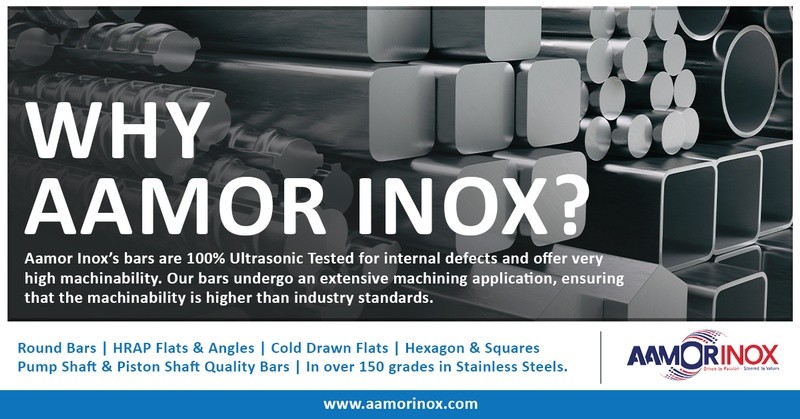
Often, people mistakenly believe that stainless steel is a single material. In reality, stainless steel refers to a family of corrosion-resistant steels. Therefore, it is very important for a consumer to understand the distinctive properties of various families and grades of stainless steel so that he can make an informed decision.
Even though stainless steel owes its corrosion resistance primarily to chromium, there are many combinations of metals available in the market today, which also fall within the category of ‘stainless steel’.
When you try to find the best option of stainless steel, you must determine the precise kind of alloy you require for your purpose. That will also help you identify the optimal price point according to your need.
The two major stainless steel labels are:
a) Families
b) Grades
Stainless Steel Families
The term ”stainless steel families” in this case refers to specific properties of that particular alloy. Different families have different ratios of various metals in the alloy. The four prominent stainless steel families include:
a) Austenitic
b) Ferritic
c) Duplex
d) Martensitic and Precipitation Hardening Stainless Steel
While families act as a differentiator at one level, you need to really look at grades of stainless steel to appreciate what separates one variety from another. Various grades refer to specific properties of the alloy such as toughness, magnetism, corrosion-resistance, and alloy composition.
Common stainless steel families and grades along with their characteristics:
Pairing a family and grade together gives you a good indication of what to expect from a particular stainless steel alloy. Be it magnetism, toughness, corrosion-resistance or heat-resistance, you can learn about everything by focusing on these two aspects.
The following classifications will make you aware of what to expect within each family as well as common grades.
Austenitic: This is the most widely used family of stainless steel worldwide. It mostly includes chromium and nickel, though some grades also include manganese and molybdenum. Austenitic stainless steel is non-magnetic when annealed with a solution. However, there are also certain cold worked grades that are magnetic. Heat-based hardening does not work for this type of stainless steel. However, it promises excellent corrosion-resistance and is also highly weldable. Austenitic stainless steel’s popular grades include 303, 304, 316, 310, and 321 grades.
Ferritic: This is one of the most cost-effective families of stainless steel available in the market. It has a low nickel content but includes chromium, molybdenum, niobium, and/or titanium. These metals improve the toughness and creep resistance of this alloy. This variety is magnetic, highly corrosion-resistant and weldable. Its most popular indoor applications include kitchenware, exhaust etc. This family is well-suited for applications where cost and performance matter more than visual appeal. Common grades of ferritic stainless steel include 409 and 430 grades.
Duplex: This family includes most of the recent and proprietary stainless steel alloys. If you opt for duplex grades, you can benefit the most from its properties, which are a combination of both austenitic and ferritic stainless steels’ properties. When it comes to the Duplex family of stainless steel, its characteristics depend upon the specific alloy. The characteristics include weight, toughness, and tensile strength. A number of alloys are created based on specific industrial concerns. This family of stainless steel is also available in a chloride-resistant variety, which is popular in offshore use. In this family, the common grades include 318L, LDX 2101, LDX 2304, 2507, and 4501.
Martensitic and Precipitation Hardening: Martensitic and precipitation hardening steels are the most common of the four major families of stainless steel. These are popular in applications that need a precise and hardened edge. This family is also the best choice for making knives, scissors, razors, and medical tools. This stainless steel alloy promises moderate to good corrosion-resistance and retains its magnetism after hardening. 410 and 420 grades are the common grades of martensitic and precipitation hardening steels. Be it making ornamental structures or rugged industrial applications, stainless steels have a wide range of usages and applications. It is crucial to understand the unique characteristics of different stainless steel alloys so that you make the right choice.
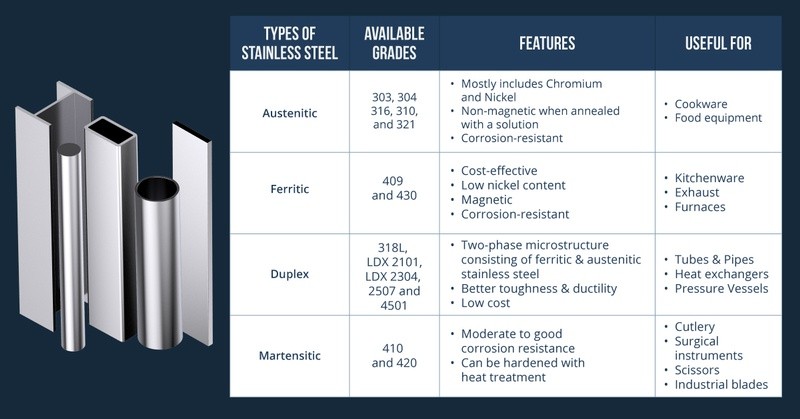
Steel as a broad term is loosely used to refer to an entire family of metal alloys. It is a common, highly versatile metal with a wide range of applications and uses. Steel comes in different grades but generally speaking, it can be divided into two categories: a) Carbon Steel b) Stainless Steel.
The basic attribute that differentiates the two is the chromium content. While carbon steel contains less than 10.5% of chromium, stainless steel must have at least 10.5% of chromium to be classified as the same. It is this characteristic that lends different properties to the two types of steel.
Difference between Stainless Steel and Carbon Steel:
Stainless Steel
This is mainly defined by the addition of chromium, along with certain other alloying elements such as nickel. It is also termed as ínox’ steel, as it is crafted to protect against oxidization, and hence, it is ínoxidizable’. Equipped with the protective layer of chromium which safeguards the metal’s iron content from being oxidized due to exposure to environmental oxygen, stainless steel is corrosion-resistant and thus called ‘stainless’.
Types of Stainless Steel
Depending on the chromium levels, stainless steel can further be divided into various categories. Usually, stainless steel with lower chromium content is cheaper and less durable. The following are the types of stainless steel with different properties:
Austenitic: This is the most widely used type of stainless steel, offering low yield strength but strong corrosion and heat resistance. It is commonly used in housewares, industrial piping and vessels, construction, and architectural facades.
Ferritic: This form of stainless steel usually does not contain nickel. However, this promises better corrosion, heat, and cracking resistance as compared to most other types. This form of stainless steel is frequently used in washing machines, boilers, and indoor architecture.
Martensitic: This is usually magnetic and due to its low chromium content, is not as corrosion-resistant as other types of stainless steels. It’s also very strong, and therefore, it’s used to make knives and turbine blades.
Duplex: This is a composite of austenitic and ferritic steels, and is thus, very strong and flexible. It boasts twice the yield strength of austenitic stainless steel and finds wide usage in industries such as paper, pulp, shipbuilding, and petrochemical industries.
Precipitation: This type of stainless steel has the same level of corrosion resistance as austenitic metals, but can be hardened to make it even stronger by adding other elements such as aluminum, copper, and niobium.
Advantages of Stainless Steel
– Corrosion-resistant
– High and low temperature-resistant
– Comes in different types
– Strong and highly durable
– Low-maintenance and can be easily cleaned
– Long-lasting
– Low-priced as compared to its lifespan
– Can be customized for an attractive cosmetic finish
– Does not tarnish easily
– Environment-friendly and recyclable
Applications:
Stainless Steel has a range of applications in many industries. The first industrial application of stainless steel took place way back in the 1930s by Ford, in the automotive industry. Ever since then, it has made its way into cars for exhaust systems, grills, trims, and different structural components. It is also used in aircraft construction, for making aeroplane frames, jet engines, and landing gear. Its corrosion-resistance and low-maintenance properties makes stainless steel highly useful for transporting and interacting with chemicals. Medical technology uses stainless steel too.
Thanks to its strength, resistance, and flexibility, certain types of stainless steels are used in architecture. The aesthetic features and attractive finish of stainless steel further enhance its desirability in architectural applications. It can also be cleaned easily. No wonder stainless steel’s price is considerably higher than carbon steel.
Besides, stainless steel is commonly used in the food and catering industry to manufacture cookware, cutlery, kitchen accessories, and appliances. It is interesting to note that the less ductile grades of stainless steel are used to make utensils such as knives, while the more ductile grades are used in the manufacture of grills, ovens, saucepans, and sinks.
Carbon Steel
As mentioned before, this type of steel has far lower chromium levels. Instead, it is formed from a carbon-like alloy with a few other materials. The carbon content in this is usually 2-2.5%. Though unlike stainless steel, carbon steel is susceptible to rust, the latter is cheaper and has different mechanical properties depending on its carbon content. Low-carbon steels are generally softer, and hence, can be machined and welded easily. On the other hand, high-carbon steel is stronger, but it is also much harder to process.
Types of Carbon Steel
It is the carbon content that constitutes the defining element of any carbon steel alloy. The various types of carbon steel can be categorized as follows:
Low-carbon steel: This is the most widely used form, with the carbon content being less than 0.25%. Since this is relatively weaker and softer but is more ductile and can be easily welded, this type of carbon steel is used for machining and welding at a low cost.
Medium-carbon steel: This variety usually has a carbon content of 0.25-0.6% and manganese content of 0.6-.1.65%. It can be improved via heat treatment. However, this can be performed only on very thin sections unless alloying elements are added. It is stronger but not as ductile as low-carbon steel.
High-carbon steel: This is the hardest and toughest type of carbon steel. It is the least ductile and is highly resistant to wear and tear. Its carbon content varies from 0.6% to 1.25% while the manganese content is about 0.3-0.9%.

Stainless Steel Pump Shaft Quality Bars are manufactured with absolute precision to ensure that they are able to withstand extreme and exhaustive environments. Also known as Stainless Steel PSQ Bars, these bars are processed from ultra-modern combined lines and highly advanced equipment.
Aamor Inox, a high-end stainless steel round bar manufacturer in India, produces Stainless Steel Pump Shaft Quality Bars as a premium product line. These bars are tested via Ultrasonic Inspection & Eddie Current Testing to ensure these top-quality bars are devoid of any sort of internal defects. The finishing work is done using the specially-designed finishing machines that ensure the surface roughness and the size tolerances (including the out of roundness) are achieved.
Aamor Inox offers PSQ Bars in the size range of 6mm – 100 mm (1/4 – 4 inches) within lengths of up to 8 meters (upto 26 feet). The size tolerances of these PSQ Bars are available in j6, e6, h6, f6, f7, h7, f8, h8, h9, ½ of A484 etc in heat treatments such as Annealed, Solution Annealed, Quenched & Tempered (QT), Hardened & Tempered (HT), Quenched & Double Tempered (QDT). The heat treatment under rigorously high temperatures help in having a higher degree of uniformity in its molecular structure that further helps the metal to maintain its structure under extreme or evolving external conditions.
Aamor Inox also provides PSQ bars with the straightness of 0.25 mm per meter max (0.0015” per feet). This is extremely helpful to minimise the vibrations that the shafts experience during high-speed rotations. The high degree of straightness that Aamor Inox implements during manufacturing is ideal for the bars.
The PSQ bars by Aamor Inox go through an optimal crack test via Eddy Current Testing through Circograph (from Dr Foerster, Germany) and Magnetic Particle Inspection (MPI). This ensures that the bars require minimum maintenance and is effective in the long run.
Aamor Inox is rightly considered as India’s most advanced producer of ‘Specialty Stainless Steel’ long-products and manufactures semi-finished and cold-finished long products in specialty stainless steels. The brand is known for its end-to-end manufacturing and efficiently fulfils the unique requirements and specifications of all its clients. To learn more, contact Aamor Inox today!
